Endless Summer® Hydrangeas is a collection of Hydrangea macrophylla perennial shrubs that have the unique ability to re-bloom throughout the spring and summer months, giving more color and visual appeal to your garden for a longer period of time. Endless Summer® Hydrangeas are known to bloom 10 to 12 weeks longer than average Hydrangea macrophylla plants and show well in colder climates since they are able to bloom on the current season’s new growth. Here are some basic guidelines to follow that will teach you how to grow hydrangeas:
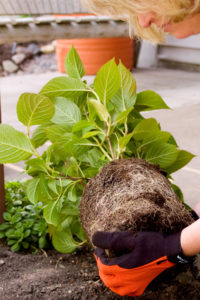 When determining where to plant your Endless Summer hydrangea macrophylla, take a walk through your yard and make note of existing garden plants, spacing availability, areas that need splashes of color and amount of sun. Especially in northern climates, the location where you plant these hydrangeas is hugely important for bloom production. The farther north you are – Zones 4-5a – the more sun your hydrangeas can handle. We recommend planting your hydrangea macrophylla in a location that allows for full morning sun with dappled shade in the afternoon. The further south you live, the less tolerant the hydrangea macrophylla is to the intense sun. Allow for 2-3 hours of morning sun with afternoon dappled or part shade.
When determining where to plant your Endless Summer hydrangea macrophylla, take a walk through your yard and make note of existing garden plants, spacing availability, areas that need splashes of color and amount of sun. Especially in northern climates, the location where you plant these hydrangeas is hugely important for bloom production. The farther north you are – Zones 4-5a – the more sun your hydrangeas can handle. We recommend planting your hydrangea macrophylla in a location that allows for full morning sun with dappled shade in the afternoon. The further south you live, the less tolerant the hydrangea macrophylla is to the intense sun. Allow for 2-3 hours of morning sun with afternoon dappled or part shade.
Other than climate, soil is the most important aspect of growing the plants that is naturally occurring. Making sure that your soil is properly prepared will hugely affect your overall plant health and bloom production. To begin, you have to determine what type of soil you have. Ask your local nursery for a soil test kit. Another home test is called the “Jar Test”. Dig down 4” and remove ¼ cup of your soil. Place that soil, along with 2 cups of water and a couple drops of dishwashing detergent, in a clear jar or plastic bottle. Shake the jar for approximately one minute and then let the contents settle for approximately 24 hours. The bottom layer to settle out is sand, with the next layer silt and the top layer (which may look like yellow-brown, red or tan water) being clay.
Once you’ve determined what type of soil you have, you can more effectively prepare the soil for your hydrangea macrophylla. The ideal soil type for these plants is loam. If you have a heavy clay soil, add gypsum to the soil to break up the clay and allow for drainage. A good rule of thumb is to apply 5 – 15 pounds of gypsum per 100 square feet. In sandy soil, peat moss can help absorb moisture. Additionally, good soil should have at least 5 percent organic matter, compost material also known as humus. This should be spread 2 – 6 inches deep across the entire bed. Hydrangeas typically grow best with a higher level of organic material. Especially in clay soil, organic matter creates air pockets that greatly help with water drainage.
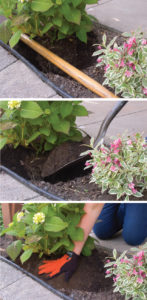 Once you have prepared your soil, lay out the plants in your intended design. Be sure to keep in mind full mature size of the plants, ensuring that they will barely touch at full size. This will make your garden look full and allow for air to still circulate through the garden. Dig your planting hole slightly larger than the pot size, and place any fertilizer (see below), organic material or nutrients needed to improve your soil mix in the hole before putting your hydrangea macrophylla in place. If the roots are tightly packed, loosen them gently with your fingers before planting the hydrangea macrophylla to encourage root growth and spread once in the ground. Make sure that the crown of the plant – where the base of the stems meets the soil – is even with the ground level. If the hydrangea is placed too high, it can easily dry out. If the crown is placed too low when planting, it can cause hydrangeas not to bloom and potentially rot. Refill the hole with soil and pack it firmly around the crown to create a water dam around the newly planted hydrangea. Fill the dam with water, let it drain and then refill it.
Once you have prepared your soil, lay out the plants in your intended design. Be sure to keep in mind full mature size of the plants, ensuring that they will barely touch at full size. This will make your garden look full and allow for air to still circulate through the garden. Dig your planting hole slightly larger than the pot size, and place any fertilizer (see below), organic material or nutrients needed to improve your soil mix in the hole before putting your hydrangea macrophylla in place. If the roots are tightly packed, loosen them gently with your fingers before planting the hydrangea macrophylla to encourage root growth and spread once in the ground. Make sure that the crown of the plant – where the base of the stems meets the soil – is even with the ground level. If the hydrangea is placed too high, it can easily dry out. If the crown is placed too low when planting, it can cause hydrangeas not to bloom and potentially rot. Refill the hole with soil and pack it firmly around the crown to create a water dam around the newly planted hydrangea. Fill the dam with water, let it drain and then refill it.
 Hydrangeas do especially well when fertilizers are effectively used in spring or early summer. We recommend using a granular, slow-release fertilizer with a high percentage of phosphorus (the middle number in the NPK ratio). Phosphorus is the element that encourages bloom production. Follow the package instructions when applying fertilizer and be sure not to use too much. Over-fertilizing can cause hydrangeas to grow big green leaves, but stunt bloom production.
Hydrangeas do especially well when fertilizers are effectively used in spring or early summer. We recommend using a granular, slow-release fertilizer with a high percentage of phosphorus (the middle number in the NPK ratio). Phosphorus is the element that encourages bloom production. Follow the package instructions when applying fertilizer and be sure not to use too much. Over-fertilizing can cause hydrangeas to grow big green leaves, but stunt bloom production.
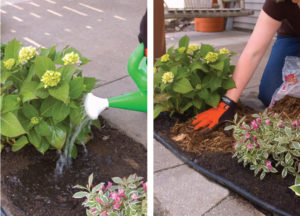 Hydrangeas prefer well-drained, moist soil, but not wet; overwatering can cause hydrangea macrophylla to produce less flowers. Depending on your soil type, you will need to adjust how frequently and how much you water. Clay soil holds more water than sandy or loam soil types, and produces more runoff because it doesn’t allow as much water to soak in as a looser sandy soil. We recommend using a drip irrigation system, a soaker hose or hand watering the shrubs when the ground feels dry. If your hydrangeas are planted in an area that sees high temperatures, they may wilt a bit in the afternoon, but will revive when the temperatures cool down. You can assist with this by watering in the morning or evening when the wind is more still and the sun less hot. Using mulch is another great way of conserving water and keeping the ground cool. Mulched plants typically can go longer periods of time between watering than non-mulched plants.
Hydrangeas prefer well-drained, moist soil, but not wet; overwatering can cause hydrangea macrophylla to produce less flowers. Depending on your soil type, you will need to adjust how frequently and how much you water. Clay soil holds more water than sandy or loam soil types, and produces more runoff because it doesn’t allow as much water to soak in as a looser sandy soil. We recommend using a drip irrigation system, a soaker hose or hand watering the shrubs when the ground feels dry. If your hydrangeas are planted in an area that sees high temperatures, they may wilt a bit in the afternoon, but will revive when the temperatures cool down. You can assist with this by watering in the morning or evening when the wind is more still and the sun less hot. Using mulch is another great way of conserving water and keeping the ground cool. Mulched plants typically can go longer periods of time between watering than non-mulched plants.
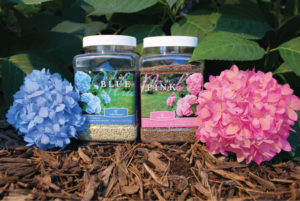 One of the most beautiful traits of an Endless Summer hydrangea is the ability to change the color of the blooms. A simple soil test from your local nursery can help determine your pH level, which will determine your hydrangea macrophylla colors. Other than Blushing Bride, which is a white hydrangea, soil with a pH below 6.0 (acidic soil) will produce blue hydrangea blooms and a pH above 6.0 will produce pink hydrangea flowers. Depending on your preference, you are able to change the color of your hydrangea colors to fit your desired color! Endless Summer has a formulated product that changes the color of your blooms. Color Me Pink™ adds garden lime to the soil to raise the pH level and produce pink hydrangea flowers. Color Me Blue™ adds soil sulfur to encourage blue hydrangea bloom development. These products are safe, organic and all-natural. There are also other natural remedies to changing hydrangea colors. To encourage blue blooms in alkaline soils, add aluminum sulfate, composted oak leaves, pine needles or coffee grounds. To encourage pink blooms in acidic soil, add wood ashes, lime or fertilizers with high levels of phosphorus (a ratio of 25-10-10 is best) to prevent aluminum from entering the plant’s system.
One of the most beautiful traits of an Endless Summer hydrangea is the ability to change the color of the blooms. A simple soil test from your local nursery can help determine your pH level, which will determine your hydrangea macrophylla colors. Other than Blushing Bride, which is a white hydrangea, soil with a pH below 6.0 (acidic soil) will produce blue hydrangea blooms and a pH above 6.0 will produce pink hydrangea flowers. Depending on your preference, you are able to change the color of your hydrangea colors to fit your desired color! Endless Summer has a formulated product that changes the color of your blooms. Color Me Pink™ adds garden lime to the soil to raise the pH level and produce pink hydrangea flowers. Color Me Blue™ adds soil sulfur to encourage blue hydrangea bloom development. These products are safe, organic and all-natural. There are also other natural remedies to changing hydrangea colors. To encourage blue blooms in alkaline soils, add aluminum sulfate, composted oak leaves, pine needles or coffee grounds. To encourage pink blooms in acidic soil, add wood ashes, lime or fertilizers with high levels of phosphorus (a ratio of 25-10-10 is best) to prevent aluminum from entering the plant’s system.
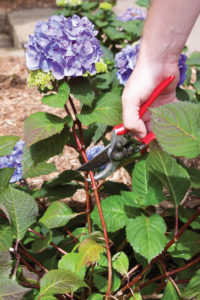 Endless Summer hydrangea macrophylla require very little pruning day-to-day, so you are able to simply enjoy the beautiful plants. These perennial hydrangeas bloom on growth from the current year as well as previous years, which allows for the re-blooming throughout the summer. If you prune too much, you will be removing potential blooms. If you prune to shape the plant or cut blooms for fresh hydrangea arrangements, be sure not to over-prune, or you will have less blooms next year.
Endless Summer hydrangea macrophylla require very little pruning day-to-day, so you are able to simply enjoy the beautiful plants. These perennial hydrangeas bloom on growth from the current year as well as previous years, which allows for the re-blooming throughout the summer. If you prune too much, you will be removing potential blooms. If you prune to shape the plant or cut blooms for fresh hydrangea arrangements, be sure not to over-prune, or you will have less blooms next year.
 If you live in an area with freezing temperatures, it is a good idea to protect your plants from freezing winter temperatures. Since Endless Summer® Hydrangeas bloom on last year’s growth (“old wood”) as well as the current season’s growth (“new wood”), you will get the most flowers by protecting the flower buds on the old wood. To do this, do NOT prune or cut back your shrubs after August 1st. Leaving the fall blooms on your plants over the winter provides winter interest, and ensures you aren’t removing buds that will become flowers in the spring and summer. Leaves, wood mulch and/or straw are good options to insulate your plants. Mound the mulch or leaves around your plants at least 12” high to protect the flower buds that will bloom early next year.
If you live in an area with freezing temperatures, it is a good idea to protect your plants from freezing winter temperatures. Since Endless Summer® Hydrangeas bloom on last year’s growth (“old wood”) as well as the current season’s growth (“new wood”), you will get the most flowers by protecting the flower buds on the old wood. To do this, do NOT prune or cut back your shrubs after August 1st. Leaving the fall blooms on your plants over the winter provides winter interest, and ensures you aren’t removing buds that will become flowers in the spring and summer. Leaves, wood mulch and/or straw are good options to insulate your plants. Mound the mulch or leaves around your plants at least 12” high to protect the flower buds that will bloom early next year.
In the spring, do not remove the mulch too fast; wait until all danger of frost has passed before uncovering to ensure beautiful blooms from old and new wood. The “old wood” buds will provide early season color and the blooms forming on current season growth will typically occur roughly six weeks later and last through the end of the season. If your hydrangeas are planted in a container, bring the entire container into your garage or a cool basement for the winter months, and follow the same steps as garden-planted hydrangeas. Container plants will not require as much mulch, but should be lightly watered throughout the winter months since they will not receive moisture from snow and rain.